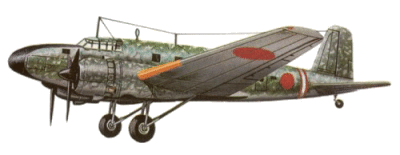
When in 1938 the
Mitsubishi Ki-21 heavy bomber began to enter service with the Imperial
Japanese Army, its capability attracted the attention of Japan Air
Lines. In consequence a civil version was developed and this, generally
similar to the Ki-21-I and retaining its powerplant of two 950 hp (708
kW) Nakajima Ha-5 KAI radial engines, differed primarily by having the
same wings transferred from a mid to low-wing configuration and the
incorporation of a new fuselage to provide accommodation for up to 11
passengers. This transport version appealed also the the navy, and
following the flight of a prototype in August 1940 and subsequent
testing, the type was ordered into production for both civil and
military use.

A Mitsubishi Ki-57-II "Topsy" of the Imperial Japanese Army during 1943
This initial production
Mitsubishi Ki-57-I had the civil and military designations of MC-20-I
and Army Type 100 Transport Model 1 respectively. A total of 100
production Ki-57-Is had been built by early 1942, and small numbers of
them were transferred for use by the Japanese navy in a transport role,
then becoming redesignated L4Ml. After the last of the Ki-51s had been
delivered production was switched to an improved Ki-57-II, which
introduced more powerful 1,080 hp (805 kW) Mitsubishi Ha-l02
14-cylinder radial engines installed in redesigned nacelles and, at the
same time, incorporated a number of detail refinements and minor
equipment changes. Civil and military designations of this version were
the MC-20-II and Army Type 100 Transport Model 2 respectively, and 406
were built before production ended in January 1945. Both versions were
covered by the Allied codename 'Topsy'.
Variants
Ki-57-I Army Type 100
Transport Model 1 - Powered by two 950 hp (708 kW) Nakajima Ha-5 KAI
radial engines and a redesigned fuselage to accommodate 11 passengers.
About 100 aircraft of this type were built including the civil version.
MC-20-I - Same as above
but built for civil use with Japan Air Lines (Dai Nippon Koku KK).
Ki-57-II Army Type 100
Transport Model 2 - Powered by two 1,080 hp (805 kW) Mitsubishi Ha-l02
14-cylinder radial engines installed in redesigned nacelles. Minor
equipment and detail refinements were also incorporated. 306 aircraft
of this type were produced before the end of production in January
1945.
MC-20-II - Same as
above but built for civil use with Japan Air Lines (Dai Nippon Koku KK).
L4M1 - A small number
of Ki-57-IIs were transferred for use by the Japanese navy as
transports and were redesignated L4M1.
(Army Type 100
Transport Model 2 - Mitsubishi Ki-57-II)
Allied Codename:
Topsy
Type: 11
Passenger Personnel Transport
Accommodation/Crew:
Pilot, Co-Pilot, Navigator and Radio Operator.
Design:
Mitsubishi Jukogyo KK Design Team to create a civil version of the
Ki-21 bomber initially for Japan Air Lines (Dai Nippon Koku KK)
Manufacturer:
Mitsubishi Jukogyo Kabushiki Kaisha (Mitsubishi Heavy Industries
Limited)
Powerplant:
(Ki-57-I) Two 950 hp (708 kW) Nakajima Ha-5 KAI radial engines.
(Ki-57-II) Two 1,080 hp (805 kW) Mitsubishi Ha-102 14-cylinder
air-cooled radial engines.
Performance:
Maximum speed 292 mph (470 km/h) at 19,030 ft (5800 m); service ceiling
26,245 ft (8000 m).
Range: 1,864 miles (3000 km) on internal fuel.
Weight: Empty
12,313 lbs (5585 kg) with a maximum take-off weight of 20,106 lbs (9120
kg).
Dimensions: Span
74 ft 1 3/4 in (22.60 m); length 52 ft 9 3/4 in (16.10 m); height 15 ft
11 in (4.85 m); wing area 754.36 sq ft
(70.08 sq m).
Armament: None.
Variants:
Mitsubishi Ki-57 (prototype), MC-20-1 (civil production), Ki-57-I Army
Type 100 Transport Model 1 (military production), MC-20-II (civil
production), Ki-57-II Army Type 100 Transport Model 2 (military
production), L4M1 (naval).
Equipment/Avionics:
Standard communications and navigation equipment.
History: First
flight (prototype) August 1940; service introduction (Ki-57-II) early
1942.
Operators: Japan
(Imperial Japanese Army & Navy), China (Nationalist Chinese Air Force -
a few captured aircraft only)
|
